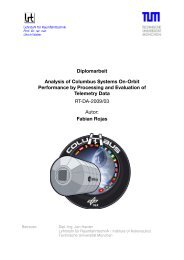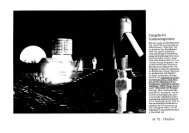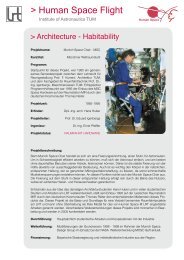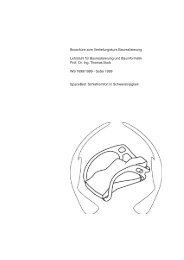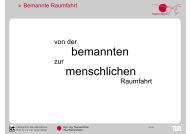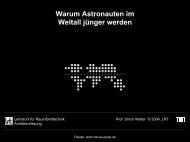Microarchitecture Space Studies Report - Technische Universität ...
Microarchitecture Space Studies Report - Technische Universität ...
Microarchitecture Space Studies Report - Technische Universität ...
You also want an ePaper? Increase the reach of your titles
YUMPU automatically turns print PDFs into web optimized ePapers that Google loves.
<strong>Technische</strong> <strong>Universität</strong> München<br />
<strong>Microarchitecture</strong> <strong>Space</strong> <strong>Studies</strong><br />
Project: personal hygiene assistant -<br />
pha<br />
Title: PHA - personal hygiene assistant<br />
Flight Dates: Oct. 26. - Oct. 29.1999<br />
Principal Investigators: Bianca Artopé, Brigitte Borst<br />
Co-Investigators: Andreas Vogler, Constance Adams, Nigel Packham, Hubert<br />
Brasseaux, Ketan S. Chhipwadia, Mary Ellen Weber, Julia Habel, Claudia Hertrich, Ralf<br />
Kircher<br />
1. Goal<br />
Proof the function of PHA in microgravity<br />
2. Objective<br />
Subject of testing is a new full-body cleansing device for astronauts in micro gravity.<br />
It is a well known problem that the three methods of body hygiene - washing, bathing, showering<br />
- are almost not practicable in micro gravity. Right now astronauts use prepacked damp towels<br />
as a substitute for taking a shower.<br />
Since November 1998 we were, in collaboration with JSC, developing the „personal hygiene<br />
assistant“ , short: PHA. This device was tested in a KC135 flight as a new, easy and effective<br />
alternative for full body cleansing.<br />
The device itself - similar to a shower head - is small enough to suit a palm and allows<br />
easy handling, as former tests already proofed. The body of the device holds a sponge in<br />
the middle . The water is injected into the sponge. A cellulose cover on top of the sponge<br />
will be touching the skin during the cleansing process and is able to take off greasy parts<br />
from the skin. This cover will be exchanged more often than the sponge. Like a ring on<br />
the outer edge of the device the suction channels are located. Therefore no water can<br />
escape and the water flow will be controlled. Another advantage is the minimization of<br />
the water consumption. Former tests with the device on the ground show that the principle<br />
functions very well.<br />
KC135 gave us a very important possibility to proof this principle in micro gravity and gain comparable<br />
test data.<br />
© 1999 all copyrights of the shown projects are with the designers<br />
and the departement for design and architecture at tu münchen<br />
Issue:<br />
Date: 12/02/1999<br />
Page: B 03




